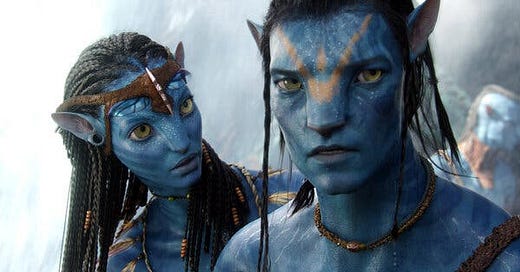Pandora’s Time Capsule: Revisiting Avatar 13 Years Later
Jackson Mahuron looks back at the original film and reflects on its technical accomplishments and what it has to say about colonialization.
The year was 2009. Barack Obama was inaugurated as President, Michael Jackson had died, and I, an 11-year-old child, was sitting in theaters to watch James Cameron’s soon-to-be biggest commercial success, Avatar. Grossing $2.92 billion , this box office behemoth stands tall as the highest grossing film of all time, and somehow it still managed to make me fall asleep when I first saw it.
A few months later, I was given the movie on DVD, and I managed to sit down and watch all 2 hours and 41 minutes of it. I remember really enjoying it (as much as an 11-year-old could) until my friend stopped by. He saw that I had just watched the movie and demanded we watch it again. So there I sat, stirring in my seat, getting angrier and angrier for another 2 hours and 41 minutes. I vowed to never watch that movie ever again.
Cut to more than a decade later. That same 11-year-old boy is now nearly 25, graduated from college, living in a big city, and waiting for the premiere of Cameron’s sequel, Avatar: Way of the Water. In order to prepare for it, I finally broke my vow and re-entered the world of Pandora.
Upon rewatch, I was shocked at how well a lot of the visuals held up. While the intense science fiction approach to the tech aboard the ships is a bit overcrowded with holograms and blue-tinted lights, I am absolutely stunned at the contrast of the photorealistic computer-generated flora and fauna of the planet of Pandora. Every creature that we see interact with the Na'vi people have incredibly unique details, and yet all have similar features such as outward lung exhausts and long antennas, dubbed “neural whips.”
These attributes imply a really impressive biological worldbuilding I don’t think I’ve seen in any other science fiction film before. Before looking into the background of how this film was made, I would never have guessed that around 60% of the movie is completely CGI. Cameron even had a version of the script ready before filming Titanic, but had to wait for the technology of the visual effects industry to catch up to what he envisioned for the project.
While the visual effects and worldbuilding are stellar, the script just did not hold up as well as I remembered. Not only is the story just a retooled Pocahontas, but Cameron managed to tell the story from the perspective of the John Smith analog. Maybe it’s easier to get away with it in 2009, but if this movie came out today, I don’t know if the story could escape the scrutiny it deserves.
Stories with Native Americans and colonizers have existed for a long time, and of course they always feature the classic “good colonizer” character who general audiences are supposed to connect with. Truthfully, I’ve always felt apprehensive about this specific kind of story. I think there are plenty of indigenous stories to tell that don’t have to otherize or fetishize their exoticness to white audiences, and those stories definitely could have a space within the industry today.
Hulu’s original Prey is a really good example of how to do this with even the most respected intellectual properties in the industry.
Cameron does the exact opposite of this, where he not only tells the lowest, most white-pleasing version of a story that indigenous people are normally featured in, but he also found a way to replace the indigenous people and their vast culture with CGI blue cat people.
On top of the white savior story, Jake Sully also happens to be one of my least favorite protagonists in recent memory. He doesn’t have much going on with his personality, but the script seems to suggest that we should care about him solely on the basis of being a disabled veteran with a dead brother. Through the power of being a white protagonist and a montage or two, Jake Sully seemingly completely understands a complex culture, is welcomed as the chosen one who will be the new leader of the Na’vi, and can even talk to the god within their Pandoran culture to help save them from the bad colonizers in just three short months.
With all that being said, of course I am not going to miss out on watching one of the best directors of our lifetime’s passion project. Cameron is so clearly driven about this world, and more importantly, he is incredibly patient to tell it the way he envisions.
My only worry is that audiences won’t share that feeling. Is 13 years too long to turn this film into a franchise? It's hard to say. It’s even harder to tell if a franchise this expensive can turn a big enough profit in a post-COVID world to justify another three subsequent films.
Either way, even if these stories aren’t totally for me, I will be in the theater opening night to see if I can feel the same movie magic he was able to capture all those years ago.





